Speak directly to the analyst to clarify any post sales queries you may have.
Seed sensing devices are redefining modern agriculture by enabling faster, evidence-based decisions and enhancing competitiveness for agribusiness leaders. As digital transformation accelerates, these solutions play a key role in driving operational efficiency, regulatory compliance, and continuous sector innovation.
Market Snapshot: Seed Sensing Devices Market
The seed sensing devices market, valued at USD 2.25 billion in 2024, is set for sustained growth with projections reaching USD 2.36 billion in 2025 and an estimated USD 3.32 billion by 2032, at a compound annual growth rate of 4.99%. This upward trajectory is fueled by rapid advancements in sensor technologies, robust adoption of digital infrastructure across agriculture, and growing demand for real-time analytics. Regulatory frameworks are enabling broader market entry, balancing support for established providers with opportunities for new entrants. The market continues to evolve, shaped by ongoing technical progress, rising expectations for reliable data, and the need to respond quickly to changing compliance standards.
Scope & Segmentation of the Seed Sensing Devices Market
- Sensor Types: Humidity sensors track both seed and soil moisture, while nutrient sensors use ion selective electrodes and optical spectroscopy for precise nutrient measurement. pH measurement devices monitor soil acidity, advanced soil moisture solutions utilize time domain reflectometry, and temperature monitoring tools help optimize plant growth environments.
- Application Areas: Seed sensing devices are essential in in-field analysis, greenhouse environments, hydroponic and vertical farming applications, as well as for research and development focused on improving crop outcomes.
- Connectivity Frameworks: Systems provide both wired connectivity such as Ethernet and RS-485, and wireless options including Bluetooth, LoRaWAN, NB-IoT, and Zigbee, ensuring adaptability for agricultural sites of all scales.
- End Users: Key adopters include commercial growers seeking precision and scale, smallholder farmers targeting improved yields, nurseries and horticultural enterprises advancing quality, research institutions driving innovation, and greenhouse operators managing diverse cultivation systems.
- Distribution Channels: Product access is provided through aftermarket dealers, specialist retailers, OEMs, certified agents, solution integrators, and digital platforms, promoting market reach and timely delivery.
- Regional Coverage: Adoption rates vary across North America, South America, Europe, the Middle East, Africa, and Asia-Pacific due to differences in infrastructure, regulatory climate, and investment in agri-innovation. This regional diversity influences market strategy and presents growth opportunities for tailored solutions.
- Company Coverage: Influential players guiding market development include Deere & Company, AGCO Corporation, CNH Industrial N.V., Trimble Inc., Topcon Corporation, Hexagon AB, KUBOTA Corporation, Yanmar Holdings Co., Ltd., CropX Analytics Ltd., and Iseki & Co., Ltd.
Key Takeaways for Senior Decision-Makers
- Seed sensing devices deliver actionable insights, helping organizations anticipate regulatory changes and proactively respond to fluctuating market dynamics.
- Integrating sensors throughout cultivation enables consistent data streams that bolster quality control and provide a foundation for reliable performance.
- Interconnected networks of these devices give immediate visibility into crop risks, making rapid intervention and optimized resource use possible.
- Flexible sourcing and assembly methods support organizational adaptability, maintaining operational readiness as industry technologies and standards evolve.
- Strategic growth requires aligning with local regulatory and policy directions, emphasizing the importance of careful due diligence in each operating region.
- Collaboration among sensor providers, connectivity partners, and agritech integrators accelerates technical advancement while ensuring smooth operational integration across supply chains.
Tariff Impact on Seed Sensing Device Supply Chains
Fluctuating tariffs are prompting firms to reassess sourcing and delivery strategies within the seed sensing devices sector. Organizations are placing greater emphasis on building domestic production, diversifying supply partnerships, and selecting vendors in regions with consistent tariff structures. This approach reduces the likelihood of distribution delays, which is particularly important as companies focus on deploying advanced, multi-parameter sensors for precision agriculture.
Methodology & Data Sources
Research for this market analysis combines direct engagement with industry leaders, manufacturers, agronomists, and greenhouse specialists. The findings are validated through patent landscape review, regulatory analysis, technology adoption monitoring, and ongoing field trials, ensuring market relevance for business stakeholders.
Why This Report Matters for Senior Decision-Makers
- The report offers an in-depth overview of the seed sensing devices innovation cycle, providing clear recommendations to support regulatory alignment and technology deployment strategies.
- Leaders will discover actionable insights to identify new growth partnerships, make informed investments, and refine regional market approaches for sustainable success.
- Guidance within this report strengthens operational resilience and prepares organizations for swift adoption of precision agriculture advances.
Conclusion
This market analysis equips decision-makers with the clarity needed to steer their organizations toward agile, resilient strategies and capitalize on emerging trends in precision agriculture.
Additional Product Information:
- Purchase of this report includes 1 year online access with quarterly updates.
- This report can be updated on request. Please contact our Customer Experience team using the Ask a Question widget on our website.
Table of Contents
3. Executive Summary
4. Market Overview
7. Cumulative Impact of Artificial Intelligence 2025
Companies Mentioned
The companies profiled in this Seed Sensing Devices market report include:- Deere & Company
- AGCO Corporation
- CNH Industrial N.V.
- Trimble Inc.
- Topcon Corporation
- Hexagon AB
- KUBOTA Corporation
- Yanmar Holdings Co., Ltd.
- CropX Analytics Ltd.
- Iseki & Co., Ltd.
Table Information
| Report Attribute | Details |
|---|---|
| No. of Pages | 195 |
| Published | November 2025 |
| Forecast Period | 2025 - 2032 |
| Estimated Market Value ( USD | $ 2.36 Billion |
| Forecasted Market Value ( USD | $ 3.32 Billion |
| Compound Annual Growth Rate | 4.9% |
| Regions Covered | Global |
| No. of Companies Mentioned | 11 |









